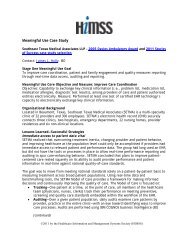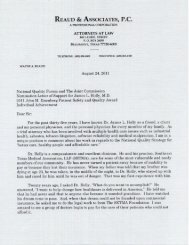HCC/RxHCC Risk Tutorial for SETMA Table of Contents - Setma.com
HCC/RxHCC Risk Tutorial for SETMA Table of Contents - Setma.com
HCC/RxHCC Risk Tutorial for SETMA Table of Contents - Setma.com
Create successful ePaper yourself
Turn your PDF publications into a flip-book with our unique Google optimized e-Paper software.
The question is, “Is this because the populations are significantly different?,” or is itbecause we have not been as effective in capturing <strong>HCC</strong>/Rx<strong>HCC</strong> <strong>for</strong> Medicare Fee-<strong>for</strong>-Service patients?. Now that <strong>SETMA</strong> is participating in an ACO, where patients are alsorisk stratified as to cost and revenue attributed to that group <strong>of</strong> patients, we need to makesure that we are being as effective in FFS as in MA.The next display is <strong>of</strong> Medicare Fee-<strong>for</strong>-Service coefficient aggregates both <strong>for</strong> acutediagnoses which have been evaluated at a visit and the chronic diagnoses which representthe patient’s problem list <strong>for</strong> which he/she is being treated. Later, this is contrasted with theE&M code distribution <strong>for</strong> each provider.By implication, we think there is a correlation between the acute diagnoses’ <strong>HCC</strong>/Rx<strong>HCC</strong>coefficient aggregate and the E&M code. The higher the <strong>HCC</strong>/Rx<strong>HCC</strong> coefficientaggregate <strong>for</strong> the acute visit, the higher it is reasonable to expect the E&M coding to be, IFthe documentation is present in the record related to two or more chronic conditions.47




